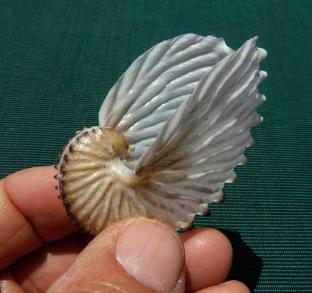Published in the Ocean Watch column, Honolulu Star-Advertiser © Susan Scott
March 14, 2011

Mollusks leave behind shells that adorn the sand like jewels. ©Susan Scott
Keeping my sailboat in the Sea of Cortez gives me excellent opportunities to see the great whales of the world, common in these nutrient-rich waters. During this visit, though, I thought small. I went crazy over mollusks.
I use the scientific term “mollusk” because the word “snail” doesn’t cover all that I found here. Mollusks are an enormous group of animals, about 50,000 living species (and 35,000 fossils) that include snails, clams, squids and octopuses. These creatures don’t look related, but they all have two common features: one muscular foot and a shell.
Sort of. In the squids and octopuses, evolution transformed the foot to tentacles and did away with nearly all of the shell. Those changes made the squids and octopuses faster swimmers than their snail and clam cousins, but they are still all mollusks.
One long-distance traveler of this large clan is the paper nautilus, an offshore octopus that roams the world’s tropical oceans. Female paper nautiluses have two special arms on their backs that secrete a white, paper-thin shell from 2-to-12 inches long, depending on the species.
This exquisite casing is a brood chamber. The female lays her eggs inside and stays there, backside in, carrying her precious eggs with her as she swims the open ocean. When the eggs hatch, the female discards the shell and begins the process again. The tiny males, much smaller than the pocket-size females, fertilize only one female and then die.
Paper nautilus shells are an uncommon beach find, the animals being scarce and the delicate cases easily broken in the shore break. My eyes nearly popped out of my head when I found a paper nautilus shell, perfectly intact, lying in the sand like the jewel that it is.
And that was just the beginning of my fabulous finds in the same area. A nearby bay contained so many living mollusks that the shells of dead ones literally tumbled in at my feet as I walked the shell-covered, 3-mile-long beach. I made my neck stiff and my back sore as I admired the homes of clams and snails I could identify, pored through books for the ones I could not, and sorted the shells I wanted to keep.
Most of the shells I collected had perfectly round one-eighth-inch holes in them, as precise as if bored by an electric drill. The holes were indeed drilled, but with living bits: the pointy, filelike tongues of moon snails and murexes.
The snails in these two families are all carnivores, each species roaming sandy ocean floors on a large, muscular foot looking for relatives to eat. When the predator finds one, it bores a hole and secretes acid on a spot of the prey’s shell. Once the hole goes through, a process that can take all day, the predator sucks out the live animal inside.
One “aha” discovery for me on that beach was the origin of the flimsy gray structures, about 2 inches in diameter, that looked like round gaskets littering the shoreline. The mystery was solved when a fellow sailor showed me a picture of my “gaskets,” moon snail egg masses known as sand collars. The female moon embeds her eggs into circles of sand, which she binds together with mucus.
Shell Heaven (my name) is remote but accessible by car. The beaches are inshore of Bahia Santa Inez on Baja’s east coast.
I wallowed in my pearly treasure trove for days but finally forced myself to put away my shells and haul up my anchor. I’ve got a boat to sail and whales to find.